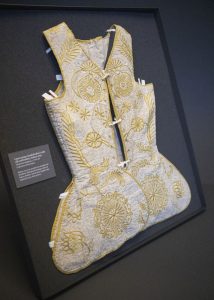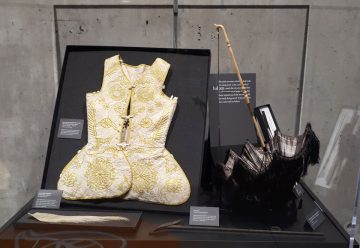Textiles are not something one might expect to encounter when working in a natural history museum, but plants and animals have both contributed to clothing our species since we first thought of the idea. We’ve found many materials over the millennia to garb ourselves with, both for protection and style.
Fur and leather of many animals have been used for thousands of years. Wools from sheep, goats, camelids (like alpacas and dromedaries), angora rabbits and even the underfur of some dogs have been used for centuries. We’ve used horns, tusks and baleen to create parts of garments like corset stays, buttons and carved ornamentation. And of course we humans love the colours of feathers!
The Chinese have been making silk since at least 3000 BCE, though there’s evidence that they may have started several millennia earlier. Silk was a carefully and zealously guarded secret. China maintained a monopoly on the process of raising silk worms and silk making, all known as seri-culture, until around 200 BCE, when Chinese immigrants brought this knowledge with them to Korea. Since then, silk manufacture has spread far and wide, though China and Japan are still the prime manufacturers.
In addition to animals, there are many plants we have used for creating clothing. Cotton is such a major part of the textile industry, wars have been fought over it. These days, hemp, bamboo and soy are seeing a resurgence. Linen, made from flax, dates back to the stone age. Other textiles include Lyocell from eucalyptus trees, ramie from an Asian plant in the nettle family, and the inner bark of cedars on the Pacific coast. Pineapple is used in the the Philippines to make a delicate embroidered cloth. Throughout Asia various banana plants are used, including a variety known commonly as Manila hemp.
From a conservation perspective, the problem with textiles is that any item made from natural organic materials tends to deteriorate rather quickly over time. Textiles, whether plant or animal based, are one of the first things to rot in an archeological site. This fragility one of the main reasons that storage conditions are so important to preserving old textile pieces. Excess moisture can induce moulds to grow, or pests, such as moths, to eat the textiles or burrow into them seeking shelter. An extremely arid climate can allow the textile to dehydrate, breaking down the fibres or cracking leather. Exposure to UV from sunlight or other light sources can weaken fibres and fade dyes. Ideally, an old textile garment should be stored flat, on an acid free surface, and its normal folding parts like sides or sleeves should be supported inside by rolls of foam or acid-free tissue paper. Long items like quilts or weavings should be rolled around a tube wider than their width and wrapped with a cover. No light, or low light are best for storing textiles.
Mounting textiles includes its own set of skills. I’ve had the privilege of getting to mount several interesting pieces over my years at the Beaty, most of them from the collections of Clause Jahnke and Ivan Sayers. The first textile mounts I made at the Beaty, in 2013, were for a feature exhibit called Invoking Venus, which looked at the ways humans have used animal parts in clothing or were inspired by them in designing textiles. One particular piece was a strip of lace from a man’s garment, dated from the 1700’s. It depicted scenes from a hunt on horseback and what looked like a man wearing a tribal headdress, along with other details of plants, a boat and a various animals.
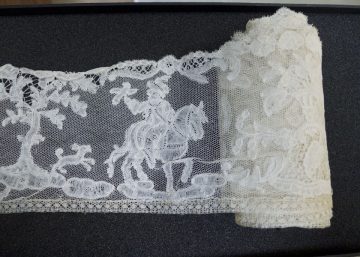
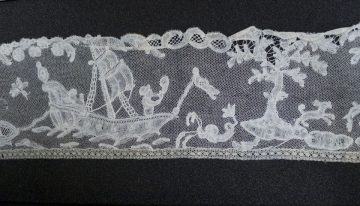

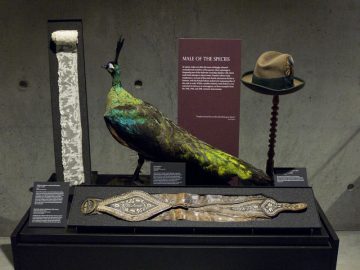
There was at least a meter of lace in this sample, but I could only show off so much of it, as it needed to fit into a case titled the Male of the Species, which also included a leather belt from German lederhosen, a feathered fedora and a peahen – since we couldn’t fit a peacock in the case. In the interest of supporting the lace and showing it off well, I decided to use a nearly-vertical foam tray mount, held upright by a brass stand to support it. The brass piece that held the roll of lace on the top of the mount was bolted in from the back of the tray and remained mostly invisible to someone viewing the piece from outside the case. The stand was anchored into a piece of wood for its base.
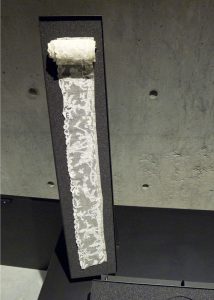
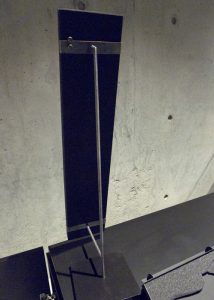
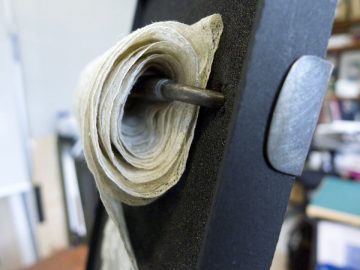
***

The next textile collection was from Skin & Bones, a feature exhibit in 2018 that included back-lit images of animal parts by Catherine Stewart and cases featuring fashion items made from leather, baleen, bones, tusks and ivory. These were from the collections of Jahnke and Sayers. One of the pieces was a jumps from the late 1600’s. For those who’ve never heard of a jumps, it was a sort of women’s jacket, stayed with baleen strips. A jumps was worn under the top layer of a dress bodice and over the undergarments. This one was made of beautiful off-white cloth, perhaps linen or cotton, with golden yellow embroidery all over it. This precious garment came folded up in a box, along with extra stays for display.
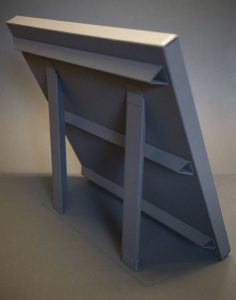 As I designed the baleen case layout, I knew I needed to somehow keep the mount for the jumps close to upright for almost a year. It needed a sturdy, structured tray mount, along with a lot of foam and tie downs to keep it supported.
As I designed the baleen case layout, I knew I needed to somehow keep the mount for the jumps close to upright for almost a year. It needed a sturdy, structured tray mount, along with a lot of foam and tie downs to keep it supported.
The jumps had some weight, as it was a layered, boned and ornamented piece. Conservationally speaking, it was in good condition overall, with very few worn out places in the cloth, which always makes my job easier. I measured and cut the piece of foam which would provide the main support for the garment. I laid the jumps on the foam so I could determine where tie downs, made with cotton twill tape, could be placed without damaging the cloth. Carved foam spacers provided an anchor for the ties and supported the front layer of the jumps. All the cotton tape was tied firmly on the back of the main foam piece.
The jumps remained on display in this mount for roughly 11 months. After Skin & Bones was deinstalled, I was very pleased to discover that almost no sag had taken place on the garment. The only bits that had shifted could be seen at the bottom hem of the back flaps and were very minor. This was a good indication that I’d made the right mount.

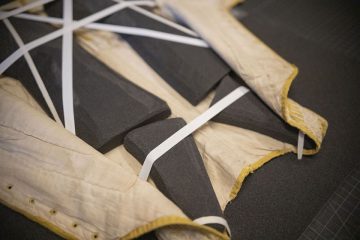
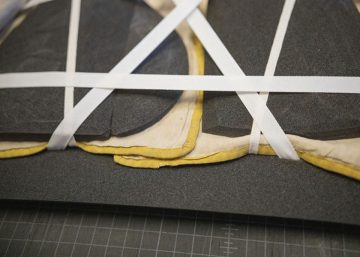 There were a few other additions to the jumps to help it keep its shape. I added three cotton twill ties to the front lacing holes to keep it together and holding steadily, but I kept them minimal to indicate that they were not an original part of the garment. You can see that the edges of the tie downs were visible on the mounted jumps, but using black ties instead of white would have been too obvious against the cloth. The foam spacers are partially visible. While the normal aim of mountmaking is to hide the mechanics of how I support objects or specimens, sometimes I have to strike a balance between presentation and conservation.
There were a few other additions to the jumps to help it keep its shape. I added three cotton twill ties to the front lacing holes to keep it together and holding steadily, but I kept them minimal to indicate that they were not an original part of the garment. You can see that the edges of the tie downs were visible on the mounted jumps, but using black ties instead of white would have been too obvious against the cloth. The foam spacers are partially visible. While the normal aim of mountmaking is to hide the mechanics of how I support objects or specimens, sometimes I have to strike a balance between presentation and conservation.
